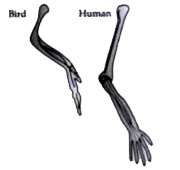Explain the terms analogous and homologous organs with examples.
Video Solution
Text Solution
Homologous organs are similar in origin (or are embryologically similar) but perform different functions. For example, the forelimbs of humans and the wings of birds look different externally but their skeletal structure is similar. It means that their origin is similar (as wings in birds are modifications of forearm) but functions are different - the wings help in flight whereas human forearm helps in various activities.

Analogous organs, on the other hand, have different origin but perform similar functions. For example, the wings of a bird and a bat are similar in function but this similarity does not mean that these animals are more closely related. If we carefully look at these structures, then we will find that the wings of a bat are just the folds of skin that are stretched between its fingers whereas the wings of birds are present all along the arm. Therefore, these organs are analogous organs.
|
Updated on:21/07/2023
Topper's Solved these Questions
- BOOK - OSWAL PUBLICATIONCHAPTER - HEREDITYEXERCISE - NCERT EXEMPLAR (MULTIPLE CHOICE QUESTIONS )25videos
HEREDITY
- BOOK - OSWAL PUBLICATIONCHAPTER - HEREDITYEXERCISE - NCERT EXEMPLAR (SHORT ANSWER QUESTIONS)11videos
HEREDITY
- BOOK - OSWAL PUBLICATIONCHAPTER - HEREDITYEXERCISE - NCERT CORNER (INTEHT QUESTIONS )17videos
HEREDITY
- BOOK - OSWAL PUBLICATIONCHAPTER - DIKSHA QUESTIONS EXERCISE - ENVIRONMENT (MULTIPLE CHOICE QUESTIONS)6videos
DIKSHA QUESTIONS
- BOOK - OSWAL PUBLICATIONCHAPTER - HEREDITY AND EVOLUTION EXERCISE - CREATING BASED QUESTIONS11videos
HEREDITY AND EVOLUTION
Similar Questions
Knowledge Check
- Question 1 - Select One
Homologous organs explain
AConvergent evolutionBDivergent evolutionCPedogenesisDProdagility - Question 2 - Select One
An example of homologous organs is
Aour arm and a dog’s fore-leg.Bour teeth and an elephant’s tusks.Cpotato and runners of grass.Dall of the above. - Question 3 - Select One
An example of homologous organs is
Aour arm and dog's fore-legBur teeth and an elephant's tusksCpotato and runners of grassDall of the above
Homologous and Analogous Organs
View SolutionExplain analogous organs and homologous organs. Identify the analogous and homologous organs amongst the following:
Wings of an insect, wings of a bat, forelimbs of frog, forelimbs of a human.View SolutionExplain analogous organs and homologous organs. Identify the analogous and homologous organs amongst the following:
Wings of an insect, wings of a bat, forelimbs of frog, forelimbs of a human.View SolutionAn example of homologous organs is
View SolutionAn example of homologous organs is
View Solution
